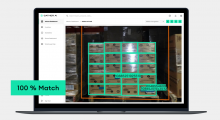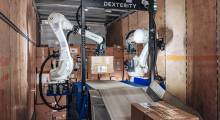Those in manufacturing already know the industry is among the most targeted sectors for cyberattacks. More than half of the manufacturing plants participating in a recent survey by LNS Research admitted they had experienced at least one cybersecurity breach over the past year.

Although this is nothing new, the industry is becoming increasingly susceptible to such attacks as additive manufacturing (AM) gains wider acceptance, bringing with it a more decentralized approach that allows for companies to manufacture when and where needed. This model certainly has significant benefits, but it also substantially increases the chances for counterfeit, poor quality or uncertified parts to enter the supply chain as ever-increasing amounts of product data travel back and forth between manufacturers, suppliers and subcontractors.
Blockchain Mandate
To maintain the integrity and traceability of the AM digital flow, it is essential to secure supply chain data with blockchain at each phase of the digital supply chain. This begins at the design phase, where design file encryption can ensure that only authorized users have access to the enclosed information. An encrypted digital container should be developed for each part, and prevent access until the design files are decrypted. Access to the data, length of time that it is accessible and how the data should be used can all be defined by the intellectual property owner via a licensing mechanism.
As the next step in the manufacturing process, the parts designer would transmit encrypted design files and a digital license to the downstream users in the digital supply chain, typically through email, an offline system or direct access to the company’s server. Again, it’s essential to use a smart contract-enabled blockchain here to authenticate, transport and record the digital distribution license. This enables all members of the blockchain to participate, while simultaneously enforcing the distribution and asset management rules set by the smart contract.
From that point on, parts production is typically licensed to multiple manufacturers, each of whom will use the design files to produce parts according to the licensing agreement’s digital parameters. Manufacturers will only be able to decrypt the design files once they meet specifications on the equipment make and model, the type of build materials allowed and other parameters. To ensure quality standards and prevent counterfeits from being made on authorized equipment, production rules control the number of parts each manufacturer is licensed to print. All activities should also be tracked and stored on the blockchain ledger to verify the origin of each part and allow any errors to be tracked to their source.
Lastly, each physical part that is manufactured should be tagged with a digital reference and recorded in the blockchain ledger. Coding parts by embedding chemical trackers, radio frequency identification or serialization numbering allows future users to trace any part back to its manufacturer, the machine that created it and the design’s original creator. The blockchain ledger can also be used for performance modeling, failure simulation and overall performance improvement of a specific part.
Countering Counterfeits
Overall, blockchain technology is critical for securing the digital supply chain, both as a hedge against lost revenue caused by intellectual property theft and to ensure safety and security. This is particularly true for those manufacturers in the government and military space. A recent Department of Defense (DoD) report noted that equipment no longer made by the original manufacturer typically must be purchased from third-party distributors, opening the door for counterfeit parts to enter the supply chain. Fortunately, AM can help offset this issue by enabling suppliers to store designs and produce the replacement parts on-demand, using the correct design file validated by the blockchain.
Although best practices for securing and authenticating data and improving the digital supply chain through blockchain-enabled security solutions still need to be determined, blockchain technology holds the key to counterfeit mitigation, data integrity, compliance rights and feedback monitoring. Incorporating blockchain into the manufacturing cycle will lead to faster production—accelerating time to market and reducing physical storage requirements—enabling AM to live up to its full potential.
Dana Ellis is senior program manager at the National Center for Manufacturing Sciences.
Article topics
Email Sign Up















